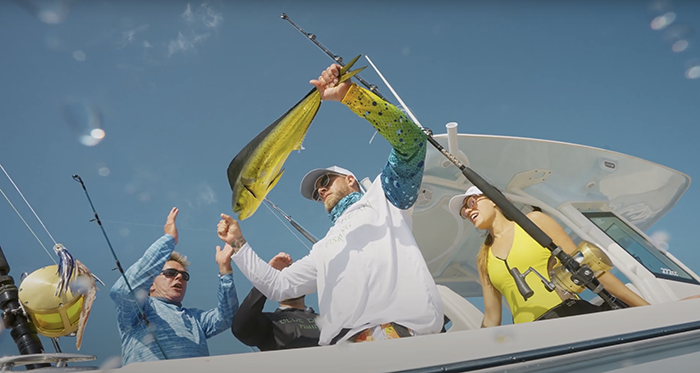DESIGN & TECHNOLOGY

Choosing the Right Fishing Line for Sailfish: A Guide to Braided vs. Mono Lines
Posted:24/04/2025 06:20AM
There’s no doubt that the proliferation of synthetic braided fishing lines has revolutionized light tackle fishing. Typically referred to simply as “braid,” these high-tech lines generally consist of gel-spun ultra-high molecular weight polyethylene fibers, known as Spectra, or Dyneema. Line companies use different numbers of strands (4, 8, 12 or 16) and line coatings which affect the roundness and castability of the braided lines.
Monofilament line is made from nylon material in the form of pellets, which are melted and then extruded into various diameters, cooled, and wound onto spools. The diameter of the nylon determines the breaking strength (pound test) of the line. So, which should you choose for your type of fishing?
Both have their place. Casters like braid because it has almost zero stretch, so you can set the hook with confidence. And the smaller diameter and slick coatings of braid allow you to put much more braided line of a certain pound test on your reel than you can with nylon mono. Braid works best for bottom fishing too. You feel every tap on your bait and the no-stretch nature of braid helps you keep big fish like grouper out of the rocks when they are hooked.
But mono may be a better choice for trolling because it does stretch some, and that can be advantageous when a large striking fish like a kingfish, tuna or wahoo attacks your bait. A little stretch may prevent a pulled hook as the line suddenly comes tight.
A close examination of how and where you fish will help you figure out where each type of line fits into your program, and if you’re like the rest of us, you’ll likely end up using both braid and mono in the appropriate situations.
Choosing the Right Fishing Line for Sailfish: A Guide to Braided vs. Mono Lines
Hello fellow anglers! If you're gearing up for an exciting sailfish fishing adventure, one of the most crucial decisions you'll need to make is choosing the right fishing line. With the two main options being braided and monofilament (mono) lines, it's essential to understand the unique properties and benefits of each to enhance your chances of landing that prized sailfish. Let's dive into the details to help you make an informed decision and improve your fishing experience.
The Advantages of Braided Fishing Lines
Braided lines are known for their exceptional strength and minimal stretch, providing excellent sensitivity to feel the subtlest of bites. When targeting aggressive sailfish, the superior strength-to-diameter ratio of braided lines allows for increased line capacity on the reel, giving you the confidence to battle powerful fish without the risk of line breakage.
Furthermore, the thin diameter of braided lines enables a smoother and faster line retrieval, an essential factor when a sailfish is making a blazing run towards the horizon. With minimal stretch, braided lines provide maximum hook-setting power, aiding in effectively penetrating the sailfish's bony mouth for a solid hook-up.
The Benefits of Mono Lines
On the other hand, monofilament lines offer their own set of advantages when pursuing sailfish. The inherent stretch of mono lines serves as a shock absorber, particularly crucial when dealing with the acrobatic jumps and powerful surges of sailfish. Additionally, mono lines possess excellent knot strength, ensuring secure connections between the line, leader, and terminal tackle.
Due to their forgiving nature, mono lines provide a degree of forgiveness for anglers, especially in scenarios where sudden bursts of speed and strength from the sailfish demand a more compliant line. This elasticity can prevent the loss of fish during high-energy runs or sudden changes in direction.
Making the Right Choice
Ultimately, the decision between braided and mono lines comes down to your fishing style, preferences, and the specific conditions of your sailfish expedition. For those who prioritize strength, sensitivity, and thin diameter, braided lines may be the ideal choice. Conversely, anglers who value shock absorption, forgiveness, and knot strength might lean towards mono lines.
Keep in mind that some anglers opt for a hybrid approach, combining both braided and mono lines in their rig setups. This method utilizes the strengths of both types of lines, with braided lines as the main line and mono leaders to capitalize on their shock-absorbing and forgiving properties when encountering sailfish's intense bursts of action.
In Conclusion
Understanding the differences between braided and mono fishing lines is vital in ensuring an exhilarating and successful sailfish fishing experience. By evaluating the specific demands of targeting sailfish and considering your individual fishing preferences, you can make an informed choice that aligns with your angling goals. Whether you opt for the strength and sensitivity of braided lines or the forgiveness and shock absorption of mono lines, your decision will undoubtedly contribute to an unforgettable sailfish fishing venture. Embrace the excitement and anticipation as you prepare to tackle these magnificent creatures on the open seas!
Search
Subscribe to The Catch






















